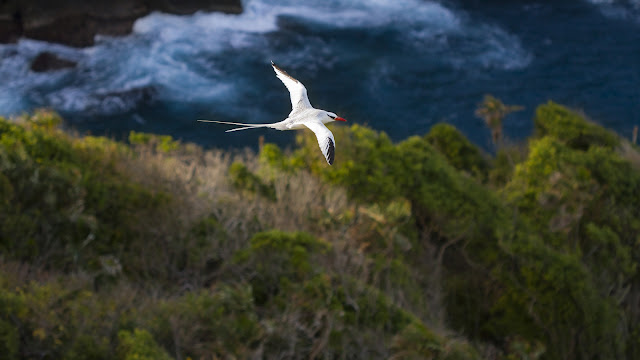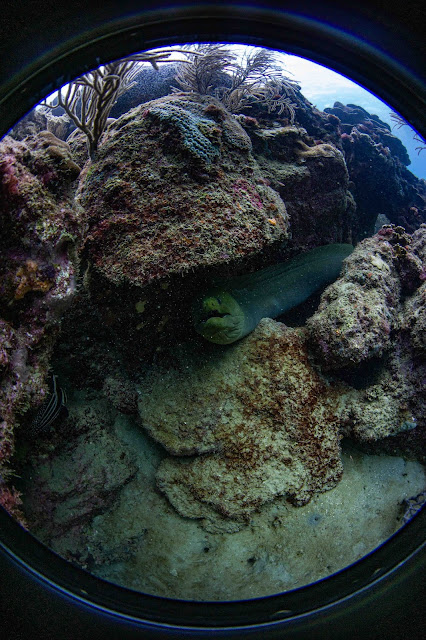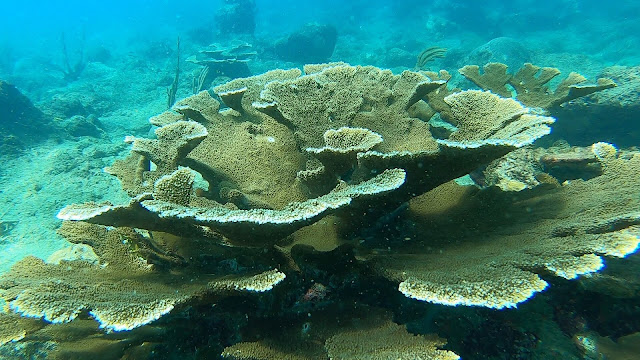Our Plastic Problem
Dr Anjani
Ganase, marine scientist, discusses one of the big challenges for humanity in
this decade: our addiction to plastic use.
The advent of synthetic plastic
products in the early 1900s was revolutionary: its durability, low cost, and
malleability allowed an array of uses. Today, plastics are used in everything
from packaging, extending the shelf life of food; machinery; electronics, as
insulation; textiles (polyester) and even building materials. Take a look
around and count the number of items you see that are made from plastic; it is
everywhere. So what is the problem with plastic?
 |
| Marine plastic debris: fishing net drapes over a coral reef in the Maldives. Photo by Christophe Bailhache, XL Catlin Seaview Survey (http://catlinseaviewsurvey.com). |
Although plastic is easy to
make it is less easy to dispose of; the material can endure through multiple
lifespans. About 8300 million tonnes of plastic have been produced over the
last 65 years; and up to 60 % of it (~4900 million tonnes) still exists in our
environment today as waste, piling up in landfills or in natural environments
(Geyer et al 2017). What does this look like? The global weight of adult humans
is estimated to be 287 million tonnes in comparison; the total amount of plastics
produced is over ten times our mass (2005 estimate; Walpole et al. 2012). The
increase in plastic production over the years is primarily associated with the
increase in single-use plastics for packaging, which are typically discarded in
less than a year. On the other hand, plastics used in construction and
industrial applications have longer life spans being used for more than 10
years before being disposed of (Geyer et al 2017). Shockingly, the majority of
the plastic waste has a history of being used only once before being thrown
away (Geyer et al 2017). The amount of waste being produced is so significant
that future geologists will be able use the plastic waste deposition as a signature
of the anthropocene (the time of the humans).
All it takes is one gust of
wind, the slip of a grip or even a deliberate toss to begin the journey of
plastic to the natural environment and in particular the ocean. Rivers act as
conduits for plastics to the ocean and the wind can carry discarded bags,
balloons and other light plastics long distances. 80% of the plastics found in
the ocean come from land, while the remainder originates from fishing and other
industries that occur in the ocean (Lamb et al 2017). It is estimated that in a
single year up to 12 million tonnes of plastic enters in the ocean, joining the
150 million tonnes that has already collected in the ocean basins (Jambeck et
al 2015). At the same time, more than about 93 million tonnes of fish are
removed from the ocean annually (FAO 2015). As fish stocks continue to be depleted,
it is also expected that in seven years (2025), the ratio of fish to plastic biomass
in the ocean will be 3:1 and by 2050 there will be more plastic in the ocean
than fish (WEF 2016). In the meantime, plastic is having a detrimental impact
on the marine life.
 |
| Land-based waste strewn along a reef next to a pier in Bonaire. Plastics include PVC piping and plastic from tyres. Photo by XL Catlin Seaview Survey (http://globalreefrecord.org) |
As plastics collect along
coastlines and on the water’s surface, heat and light tend to break up the
plastic into smaller pieces. On the surface or in the water column, fish,
turtles, sea birds, marine mammals and other marine life are ingesting bits of
plastic. The plastic then becomes integrated into the marine food web and is
passed up the food chain to larger animals including us. 90 % of all sea birds
have ingested some plastic; and for many the plastic build up in their guts will
lead to death (Wilcox et al. 2015). While it is easy to observe the impacts of
large plastic debris, micro-plastics - tiny pieces, barely visible to the naked
eye - are even more pervasive, as they are easily taken into the body of even
microorganisms. The plastic that collects on surfaces eventually drift and
collect in a major ocean gyres or sink to the bottom as marine organisms settle
on the plastic.
On the bottom, plastic pieces
are further consumed and larger pieces do more damage entrapping marine life.
Marine turtles, marine mammals and even fish often get entangled in drifting
plastic fishing lines, nets and rope, which can lead to death. Plastics also
smother benthic communities but there are other less obvious ways in which
plastics impact on them. A recent study has related plastic pollution to an
increased risk of coral diseases (Lamb et al. 2018). Corals in contact with plastic
are more likely to suffer from diseases; plastic surfaces typically encourage
concentrations of bacteria and viruses. Think about the sea birds that are crucial
to Tobago’s ecosystem, about the migratory whales that swim off Tobago’s coast
and about the litter that collects on our local reefs. How can we limit the
impacts of plastic use in the environment that is our backyard?
Our
plastic solution
Fortunately, the solution to
our plastic problem is simple: reducing our plastic consumption. While it may
be unrealistic to shift to a plastic free lifestyle, there are many steps to
reduce unnecessary plastic use in everyday activities. Personal decisions are
easy steps: bring your own shopping bags; keep a spare fork in your bag; fill
your own water bottle; swap out the plastic wrap for Tupperware containers that
are longer lasting and reusable; avoid wasteful – and unnecessary - accessories,
such as straws, drink umbrellas, balloons, confetti and glitter. Finally,
buying fresh produce from local farmers means that you can select your produce
and carry them in your own baskets or cloth bags.
The next step is to reuse the plastic
that has already been produced or purchased. Think about whether the plastic
bags or bottles can be used again before you throw them away. There are many
innovative ways to reuse plastic in our homes. Some examples include using as storage
containers, as plastic scoops, in art projects and even herb gardens. Finally,
only after we have exhausted re-use should we resort to recycling to dispose of
the plastics that cannot be used otherwise. Of all the plastics that have been
produced since the 1950s only 9 % have ever been recycled, and only a fraction
of this has been recycled more than once, which is the shocking truth about
recycling (Geyer et al 2017). Recycling would be more useful if it curbed the
production of new plastics; unfortunately, production of new plastics has
steadily increased over the years. As we move away from oil and gas, recycling
may become a more viable source of plastic in the future. Alternatively, plant
based materials are being developed as a replacement for plastic, so that containers
for instance can degrade more easily in the environment and produce less harm.
Additionally, more efficient recycling technologies are being explored to
reconstitute the plastic into other forms. For the moment, however, reducing
and reusing plastics will do much more for the environment.
References
R. Geyer, J. R. Jambeck, K. L. Law (2017) Production, use, and fate of all plastics ever made.
Sci. Adv. 3, e1700782.
Food and Agriculture Organization, United Nations (2015). FAO Global Capture Production database updated to 2015 - Summary information.
J. R. Jambeck, R. Geyer, C. Wilcox, T. R. Siegler, M. Perryman, A. Andrady, R. Narayan,
K. L. Law (2015) Plastic waste inputs from land into the ocean. Science 347, 768–771
J. B., Lamb, B. L., Willis, E. A., Fiorenza, C. S., Couch, R., Howard, D.N., Rader, J.D., True, L.A., Kelly, A., Ahmad, J. Jompa, C.D., Harvell (2018) Plastic waste associated with disease on coral reefs. Science, 359(6374), 460-462.
S.C., Walpole, D., Prieto-Merino, P., Edwards, J., Cleland, G. Stevens, I., Roberts (2012) The weight of nations: an estimation of adult human biomass. BMC public health, 12(1), p.439.
World Economic Fund (2016) The New Plastics Economy: Rethinking the future of plastics
C. Wilcox, E. Van Sebille, B. D. Hardesty (2015) Plastic in seabirds is pervasive and increasing. Proceedings of the National Academy of Sciences, 112 (38) 11899-11904
R. Geyer, J. R. Jambeck, K. L. Law (2017) Production, use, and fate of all plastics ever made.
Sci. Adv. 3, e1700782.
Food and Agriculture Organization, United Nations (2015). FAO Global Capture Production database updated to 2015 - Summary information.
J. R. Jambeck, R. Geyer, C. Wilcox, T. R. Siegler, M. Perryman, A. Andrady, R. Narayan,
K. L. Law (2015) Plastic waste inputs from land into the ocean. Science 347, 768–771
J. B., Lamb, B. L., Willis, E. A., Fiorenza, C. S., Couch, R., Howard, D.N., Rader, J.D., True, L.A., Kelly, A., Ahmad, J. Jompa, C.D., Harvell (2018) Plastic waste associated with disease on coral reefs. Science, 359(6374), 460-462.
S.C., Walpole, D., Prieto-Merino, P., Edwards, J., Cleland, G. Stevens, I., Roberts (2012) The weight of nations: an estimation of adult human biomass. BMC public health, 12(1), p.439.
World Economic Fund (2016) The New Plastics Economy: Rethinking the future of plastics
C. Wilcox, E. Van Sebille, B. D. Hardesty (2015) Plastic in seabirds is pervasive and increasing. Proceedings of the National Academy of Sciences, 112 (38) 11899-11904





